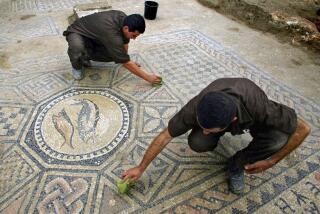Tower of David Is Window on Jerusalem History
JERUSALEM — From atop the Herodian towers of the ancient Citadel anchoring the Old City at Jaffa Gate, Jerusalem carpets the surrounding hills. The Dome of the Rock, the Mount of Olives, the expanding modern city to the west and north--it’s a million-dollar view.
In April, a new door opened on Jerusalem’s 4,000 years of history in the old stone troop quarters of the Citadel.
The Tower of David, a museum of Jerusalem’s history that cost $10 million, is distinct among its counterparts in this historic city.
“What we have here is not a collection of objects, but a story,” Prof. Yehoshua Prawer of Hebrew University, the museum’s academic adviser, said.
Chapter by historic chapter--the Canaanites, the Jewish First and Second Temple periods, Romans, Byzantines, Muslims, Crusaders, Ottomans and British--the story is told in a series of rooms mixing high-tech displays and meticulously correct models of the peoples of Jerusalem and their times.
Where little more than two decades ago Jordanian soldiers at the rifle ports looked over their sights at Israeli foes, about 1,500 tourists and schoolchildren parade the stone walkways each day to follow the story of a city considered holy by Jews, Muslims and Christians, a city conquered, destroyed and rebuilt time and again over the millennia.
High on Priority List
The new museum was high on Mayor Teddy Kollek’s priority list when Israeli troops took East Jerusalem and the Old City from the Jordanians in the Arab-Israeli War of 1967, a solid symbol of the mayor’s insistence that Jerusalem remain open to all the faiths.
But even with Kollek’s well-known persuasive powers, the Tower of David museum was a formidable project to complete.
Funded by the private Jerusalem Foundation, with a substantial boost from British philanthropist Vivien Clore Duffield and the Clore Foundation, the museum’s directors, designers and builders wrestled with soaring costs of restoration and the delicate balancing of religious presentations.
For instance, a museum official pointed out, a Muslim mosque lay within the Citadel’s walls, and it was deemed appropriate to devote that space to Jerusalem’s Islamic history. Because the exhibit rooms--all of them quarters, halls or storage places of the old Citadel--run in chronological order, the history of Jerusalem had to be laid out around the fulcrum of the mosque.
The result was worth the difficulties. An indoor-outdoor museum, the Tower of David opens through a 16th-Century gate built by the Ottoman sultan Suleiman the Magnificent. Inside, visitors can take all or part of three tours, individually with a cassette recorder or in a group with a volunteer guide.
Hologram of a Temple
The exhibit tour takes the visitor into rooms depicting the various historic periods with models, dioramas, maps and videos.
The rooms are carpeted and air-conditioned, a cooling relief in summer from the steaming stone walkways around the interior courtyard. A hologram of the First Temple and a multiscreen newsreel of the tempestuous British Mandate period are popular attractions.
For archeology buffs the excavation tour leads through the remains of Second Temple era buildings and later defensive works within the walls of the fortress. And for that million-dollar view, there’s the panorama tour atop the towers.
Along the way are three large historical models of the city in times of glory and times of destruction, graphic instructors of Jerusalem’s changing fortunes.
This is a time of some nervousness in the city. In Arab-populated East Jerusalem, where the Citadel and the museum stand, there have been sporadic incidents of violence related to the Palestinian uprising against Israeli rule in the occupied territories. None, however, have touched the museum’s visitors.
“We do have security,” an official pointed out. “And after all, this is a citadel.”
-- -- --
The Tower of David museum is open daily from 10 a.m. to 5 p.m. Saturday through Thursday, and from 10 a.m. to 2 p.m. on Friday. During June, July and August the Saturday-through-Thursday closing hour is 7 p.m.
The entrance fee is 9 Israeli shekels (about $5 U.S.), and a videocassette-tour tape can be rented for 3 shekels (about $1.75 U.S.).
English-language guided tours are offered Sunday through Thursday at 11 a.m., and are free. For groups of 25 or more a personal guide can be hired for about $40.
More to Read
Sign up for Essential California
The most important California stories and recommendations in your inbox every morning.
You may occasionally receive promotional content from the Los Angeles Times.










